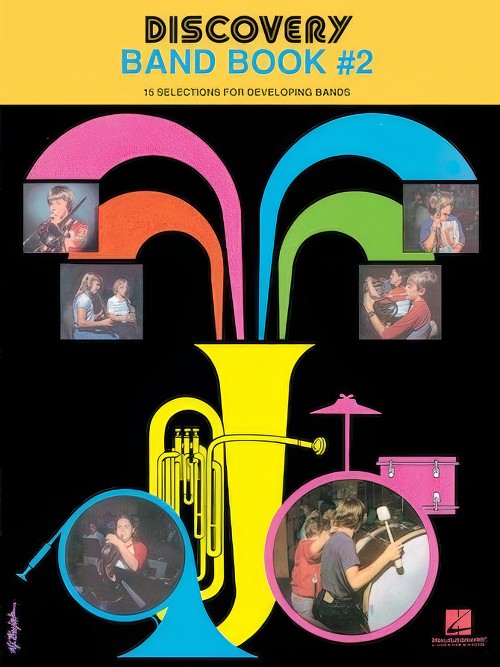Results
-
 £2.85
£2.85Discovery Band Book No.2 (Baritone TC) - Edmondson & McGinty
Contents:Concert Warm-Ups and Chorales No.2Acapulco HolidayAnchors AweighAtlantisThe Coventry CarolThe Duke of BedfordDr. DixielandIf I Were a Rich ManMickey Mouse MarchPep Rally RockSax-O-MaticSomewhere Out ThereThe Sound of MusicThree Carols for ChristmasTreasury of Carols
Estimated dispatch 7-14 working days
-
 £2.85
£2.85Discovery Band Book No.2 (Trombone/Baritone BC/Bassoon) - Edmondson & McGinty
Contents:Concert Warm-Ups and Chorales No.2Acapulco HolidayAnchors AweighAtlantisThe Coventry CarolThe Duke of BedfordDr. DixielandIf I Were a Rich ManMickey Mouse MarchPep Rally RockSax-O-MaticSomewhere Out ThereThe Sound of MusicThree Carols for ChristmasTreasury of Carols
Estimated dispatch 7-14 working days
-
 £2.85
£2.85Discovery Band Book No.2 (F Horn) - Edmondson & McGinty
Contents:Concert Warm-Ups and Chorales No.2Acapulco HolidayAnchors AweighAtlantisThe Coventry CarolThe Duke of BedfordDr. DixielandIf I Were a Rich ManMickey Mouse MarchPep Rally RockSax-O-MaticSomewhere Out ThereThe Sound of MusicThree Carols for ChristmasTreasury of Carols
Estimated dispatch 7-14 working days
-
 £2.85
£2.85Discovery Band Book No.2 (2nd Bb Cornet/Trumpet) - Edmondson & McGinty
Contents:Concert Warm-Ups and Chorales No.2Acapulco HolidayAnchors AweighAtlantisThe Coventry CarolThe Duke of BedfordDr. DixielandIf I Were a Rich ManMickey Mouse MarchPep Rally RockSax-O-MaticSomewhere Out ThereThe Sound of MusicThree Carols for ChristmasTreasury of Carols
Estimated dispatch 7-14 working days
-
 £2.85
£2.85Discovery Band Book No.2 (1st Bb Cornet/Trumpet) - Edmondson & McGinty
Contents:Concert Warm-Ups and Chorales No.2Acapulco HolidayAnchors AweighAtlantisThe Coventry CarolThe Duke of BedfordDr. DixielandIf I Were a Rich ManMickey Mouse MarchPep Rally RockSax-O-MaticSomewhere Out ThereThe Sound of MusicThree Carols for ChristmasTreasury of Carols
Estimated dispatch 7-14 working days
-
 £2.85
£2.85Discovery Band Book No.2 (Baritone Saxophone) - Edmondson & McGinty
Contents:Concert Warm-Ups and Chorales No.2Acapulco HolidayAnchors AweighAtlantisThe Coventry CarolThe Duke of BedfordDr. DixielandIf I Were a Rich ManMickey Mouse MarchPep Rally RockSax-O-MaticSomewhere Out ThereThe Sound of MusicThree Carols for ChristmasTreasury of Carols
Estimated dispatch 7-14 working days
-
 £2.85
£2.85Discovery Band Book No.2 (Bass Clarinet) - Edmondson & McGinty
Contents:Concert Warm-Ups and Chorales No.2Acapulco HolidayAnchors AweighAtlantisThe Coventry CarolThe Duke of BedfordDr. DixielandIf I Were a Rich ManMickey Mouse MarchPep Rally RockSax-O-MaticSomewhere Out ThereThe Sound of MusicThree Carols for ChristmasTreasury of Carols
Estimated dispatch 7-14 working days
-
 £2.85
£2.85Discovery Band Book No.2 (Tenor Saxophone) - Edmondson & McGinty
Contents:Concert Warm-Ups and Chorales No.2Acapulco HolidayAnchors AweighAtlantisThe Coventry CarolThe Duke of BedfordDr. DixielandIf I Were a Rich ManMickey Mouse MarchPep Rally RockSax-O-MaticSomewhere Out ThereThe Sound of MusicThree Carols for ChristmasTreasury of Carols
Estimated dispatch 7-14 working days
-
 £2.85
£2.85Discovery Band Book No.2 (Alto Saxophone) - Edmondson & McGinty
Contents:Concert Warm-Ups and Chorales No.2Acapulco HolidayAnchors AweighAtlantisThe Coventry CarolThe Duke of BedfordDr. DixielandIf I Were a Rich ManMickey Mouse MarchPep Rally RockSax-O-MaticSomewhere Out ThereThe Sound of MusicThree Carols for ChristmasTreasury of Carols
Estimated dispatch 7-14 working days
-
 £2.85
£2.85Discovery Band Book No.2 (2nd Bb Clarinet) - Edmondson & McGinty
Contents:Concert Warm-Ups and Chorales No.2Acapulco HolidayAnchors AweighAtlantisThe Coventry CarolThe Duke of BedfordDr. DixielandIf I Were a Rich ManMickey Mouse MarchPep Rally RockSax-O-MaticSomewhere Out ThereThe Sound of MusicThree Carols for ChristmasTreasury of Carols
Estimated dispatch 7-14 working days
